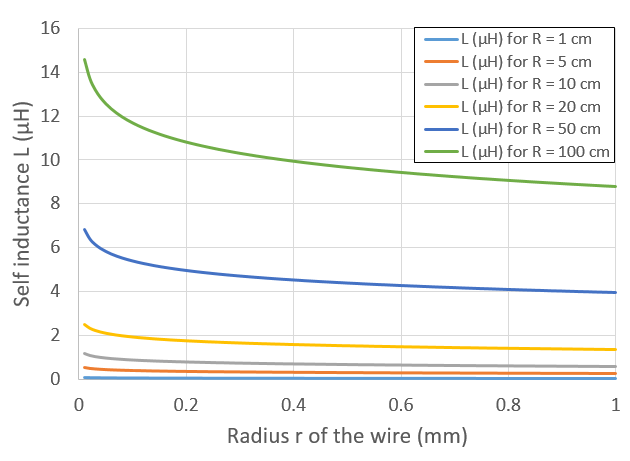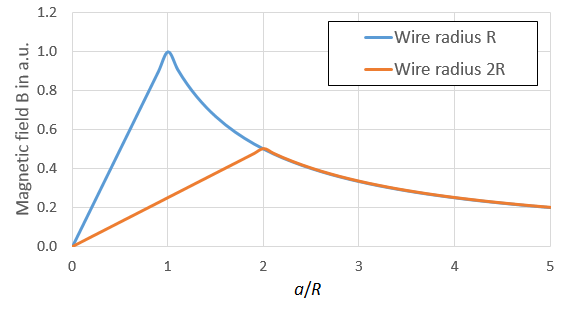About - Publications - Blog
The self inductance of a circular loop
The self inductance L of a circular loop of radius R can be approximated by [1]:
with r the radius of the wire and µ0 the permeability constant (= the permeability of free space), defined as 4π.10-7 H/m. This approximation is valid if r is much smaller than R.
Sidenote: for historical reasons, an electrical wire is often named according to its cross-sectional area. You won't find a wire with a radius of 1.0 mm in the store. But you can easily find wires of 1.5 mm² cross-sectional area. (In North America, the cross-sectional area is often expressed in terms of "American wire gauge" (AWG) instead of mm².)
The graph below plots this formula as a function of R, for different wire cross-sectional areas.
The graph below plots again this formula, but now as a function of r, for different radii R of the circular loop.
From the graphs, we can draw two conclusions:
1) The larger the radius R of the loop, the larger the self-inductance L.
This can be explained as follows. A current i in a loop generates a magnetic flux Φ. The inductance of the coil can then be determined by:
![]()
Thus, the larger the circular loop of the coil, the larger the magnetic flux Φ, and thus the larger the inductance L. This follows from the definition of magnetic flux through an area S (here the cross-sectional area within the coil):

with dS a differential element of the surface area S and B the magnetic field.
2) The smaller the radius r of the wire, the larger the self inductance L.
Intuitively, this is less easy to see. Let us consider a circular loop with radius R, through which a current I runs.
Ampère's circuital law is given by:
![]()
with Ienc the current through the surface enclosed by the contour C. If we choose for example as contour a circle with radius a>R, perpendicular to the wire and with the centre in the centre of the wire, then Ampère's circuital law becomes: B.2π.a = µ0.I, or B = (µ0.I) / (2π.a).
We notice that the magnetic field B is ~(1/a). See figure below.
This is not the case within the wire. We now apply Ampère's circuital law for the same circular loop, but with a radius a<R. The current Ienc within the circular loop is now a fraction of the total current I.
We have: Ienc/I = (πa²) / (πR²). We get: B = (µ0.I.a)/(2πR²). The magnetic field within the wire is proportional to ~a because of the different current distribution.
The figure below shows the magnetic field in arbitrairy units (a.u.) in and outside the wire for two wires with radii R and 2R. The current I running through the wires is the same. We notice that the maximum magnetic field in the wire with the smallest radius is higher than the maximum magnetic field in the wire with the bigger radius. The magnetic flux will be (a bit) higher for wires with a smaller radius, leading to a higher inductance for smaller radii.
Interesting follow-up:
Inductance: The Misconceptions, Myths, and Truth (Size Matters)
Reference:
[1] W. Greiner, Theoretische Physik, vol. 3. Frankfurt am Main: H. Deutsch, 1991



